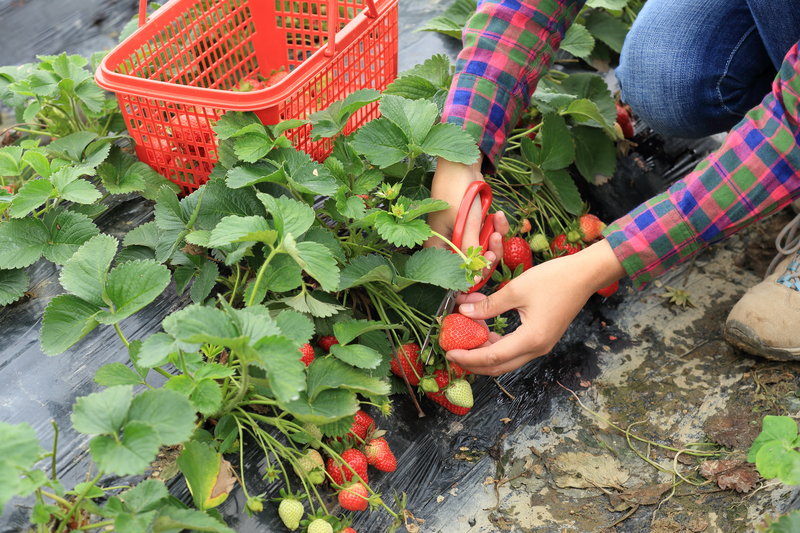Transforming Waste into Soil Enhancers
Posted on 15/09/2025
Transforming Waste into Soil Enhancers: A Sustainable Pathway
Discover how the innovative process of transforming waste into soil enhancers can revolutionize agriculture, reduce landfill overflow, and bolster environmental sustainability. As global concern over waste management and soil degradation rises, converting organic waste into valuable soil amendments is gaining momentum. Read on to explore the methods, benefits, challenges, and future prospects of waste-to-soil enhancer transformation in this informative, comprehensive, and SEO-optimized guide.

Understanding Waste and Its Impact
Types of Waste Suitable for Soil Enhancement
- Organic waste: Includes food scraps, yard trimmings, manure, and crop residues.
- Agricultural byproducts: Such as husks, stalks, and leaves.
- Industrial organic residues: Including pulp from paper mills and food processing residues.
- Compostable materials: Like cardboard and biodegradable packaging.
Organic waste is the most suitable for converting into soil enhancers, as it decomposes naturally, supplying nutrients back to the earth. Conversely, non-organic waste (plastics, metals, chemicals) can harm the environment and must be processed differently.
The Environmental Burden of Untreated Waste
- Landfill overload: Overflowing dumps create greenhouse gases and leachates contaminating soil and water.
- Resource depletion: Discarded organic matter holds valuable nutrients lost forever if not recycled.
- Soil degradation: Continuous farming without nutrient replenishment diminishes soil health, leading to erosion and poor yields.
Transforming Organic Waste into Valuable Soil Enhancers
Composting: The Foundation of Waste-to-Soil Transformation
Composting is the most widely practiced and accessible method for turning various organic wastes into fertile compost. The process involves controlled aerobic decomposition of organic matter by microorganisms.
- Materials: Mix green (nitrogen-rich) and brown (carbon-rich) waste.
- Process: Aerate regularly to supply oxygen, maintain moisture, and balance carbon-to-nitrogen ratios.
- Product: Finished compost is rich in humus, enhancing soil structure, water retention, and nutrient content.
Benefits of transforming organic waste through composting:
- Reduces landfill waste
- Cuts greenhouse gas emissions
- Improves soil fertility
- Promotes sustainable agriculture
Vermicomposting: Harnessing Worm Power
In vermicomposting, specialized earthworms break down organic waste into nutrient-rich worm castings--an exceptional soil enhancer with higher microbial activity than standard compost.
- Inputs: Kitchen scraps, manure, paper, and plant waste.
- Advantages: Faster breakdown, higher nutrient content, and improved disease resistance for plants.
- Challenges: Requires careful moisture, temperature, and feedstock management to maintain worm health.
Biochar: Turning Waste into Carbon-Rich Enhancers
Biochar is a stable, carbon-rich material produced by pyrolyzing organic waste (i.e., heating without oxygen). Used as a soil enhancer, biochar increases water retention, boosts microbial life, and sequesters carbon, reducing greenhouse gas emissions.
- Sources: Agricultural residues, wood chips, manure.
- Benefits: Improves soil aeration and growth, locks away carbon for centuries.
- Potential: Supports climate change mitigation efforts.
Digestates from Anaerobic Digestion
Certain facilities utilize anaerobic digestion to break down waste without oxygen, producing biogas for energy and digestate for soil enhancement.
- Feedstock: Animal manure, food waste, plant material.
- Process: Bacteria digest organic matter in oxygen-free tanks, yielding methane (energy) and nutrient-rich digestate.
- End-use: Digestate is applied to farmland, providing readily available nutrients like nitrogen and phosphorus.
Soil Enhancers Derived from Waste: Types and Functions
Compost as a Soil Conditioner
Compost improves soil tilth, enhances water retention, and supplies a broad range of macro- and micronutrients. Its use can replace or reduce chemical fertilizer dependence and foster a healthy soil biome.
Worm Castings and Vermicompost
Worm castings are especially high in plant-available nutrients like nitrogen and potassium and contain beneficial microorganisms. When mixed into soil, they increase seed germination rates, stimulate plant growth, and protect against certain plant diseases.
Biochar: Carbon Boost for Soil Health
Incorporating biochar created from waste not only enriches soil but also helps trap atmospheric carbon, aiding in climate change mitigation. It's especially beneficial to sandy or depleted soils due to its high porosity.
Digestates: A Liquid Fertility Booster
Digestates from biogas plants are usually in a semi-liquid state, rich in plant nutrients and organic matter. Applying them to farmland recycles nutrients, improves soil structure, and supports circular agriculture.
How Transforming Waste into Soil Enhancers Benefits the Environment
- Reduces landfill and pollution: Diverting organic waste prevents methane emissions and groundwater contamination.
- Replenishes soil nutrients: Recycling waste restores nutrients, reversing soil depletion.
- Supports biodiversity: Enhanced soils support beneficial microbes, insects, and plants.
- Improves crop yields and quality: Healthier soils mean more productive, nutrient-rich harvests.
- Combats climate change: Processes like biochar production and composting store carbon in soil.
Case Studies: Real-World Impact
San Francisco's Zero Waste Program: Mandatory composting since 2009 has diverted countless tons of food and yard waste from landfill, converted into compost for California's vineyards and farms, boosting soil health and local economies.
India's Village Vermicomposting Initiatives: Rural communities transform crop residues into vermicompost, fostering self-reliance, improving soil, and generating additional income streams for farmers.
Challenges in Waste-to-Soil Transformation
- Contamination: Non-organic waste and hazardous materials can render compost unsafe.
- Collection logistics: Efficient separation and collection of organic waste requires ongoing community education and infrastructure.
- Quality control: Maintaining consistent nutrient profiles in end products is crucial for reliable soil enhancement.
- Economic barriers: Upfront costs for processing equipment, transport, and facility operation can be significant, especially for large-scale operations.
Overcoming Obstacles: Building a Circular Economy
Community Engagement and Education
- Public awareness campaigns to separate organics from recyclables and garbage.
- School programs highlighting the importance of waste diversion and composting.
- Incentives -- such as cheaper waste fees for proper separation -- to encourage compliance.
Technological Innovations
- Advanced sorting systems using AI and robotics to prevent contamination.
- Small-scale digesters and efficient composting units for urban and rural communities.
- Mobile apps guiding residents on proper waste sorting and composting.
Policy and Regulation
Legislation mandating organic waste diversion, offering subsidies for composting facilities, and setting clear safety standards for soil enhancers derived from waste are critical for systemic change.
How to Transform Waste into Soil Enhancers: A Step-by-Step Guide
Home Composting
- Step 1: Separate organic waste from recyclables and trash.
- Step 2: Collect a mix of greens (vegetable scraps, coffee grounds) and browns (leaves, shredded paper).
- Step 3: Layer in a bin or pile, moisten gently, and turn regularly.
- Step 4: After several months, harvest dark, crumbly compost to nourish your garden or houseplants.
Community-Scale Composting Programs
- Participate in or start a local composting initiative.
- Work with neighbors to collect organic waste and process it communally.
- Share finished compost among gardens, parks, or sell to local farms.
On-Farm Waste Recycling
- Utilize crop residues, manure, and leaf litter for on-site composting or anaerobic digestion.
- Return finished soil enhancers directly to fields, closing the nutrient loop and saving on chemical fertilizers.

Innovative Future Prospects in Waste-to-Soil Enhancer Technology
Emerging technologies promise a new era of efficiency and impact for waste-derived soil enhancers:
- Smart composting systems with IoT sensors track moisture, temperature, and decomposition, ensuring optimal conditions and quality output.
- Designer microbial inoculants accelerate breakdown and tailor composts for specific crops or soil needs.
- Biomass-to-biochar reactors become more portable and affordable, letting farmers create their own soil amendments on-site.
- Blockchain-powered waste tracking guarantees transparency and safety in organic waste supply chains.
Conclusion: A Greener Future by Converting Waste into Soil Enhancers
Transforming waste into soil enhancers bridges the gap between sustainable waste management and regenerative agriculture. By embracing composting, vermicomposting, biochar, and anaerobic digestion, communities and farmers can reduce environmental impact, improve soil health, and build a more resilient future.
Get started today by composting at home or supporting local waste-to-soil initiatives, and unlock the full potential of your food and yard waste!
Key Takeaways:
- Transforming organic waste into soil enhancers reduces pollution and enhances soils naturally.
- Multiple methods--including composting, vermicomposting, biochar production, and anaerobic digestion--make this possible at various scales.
- Quality control, effective policy, education, and ongoing innovation are crucial for mainstream adoption.
By turning waste into value, we nurture the planet and ensure more sustainable harvests for generations to come.

